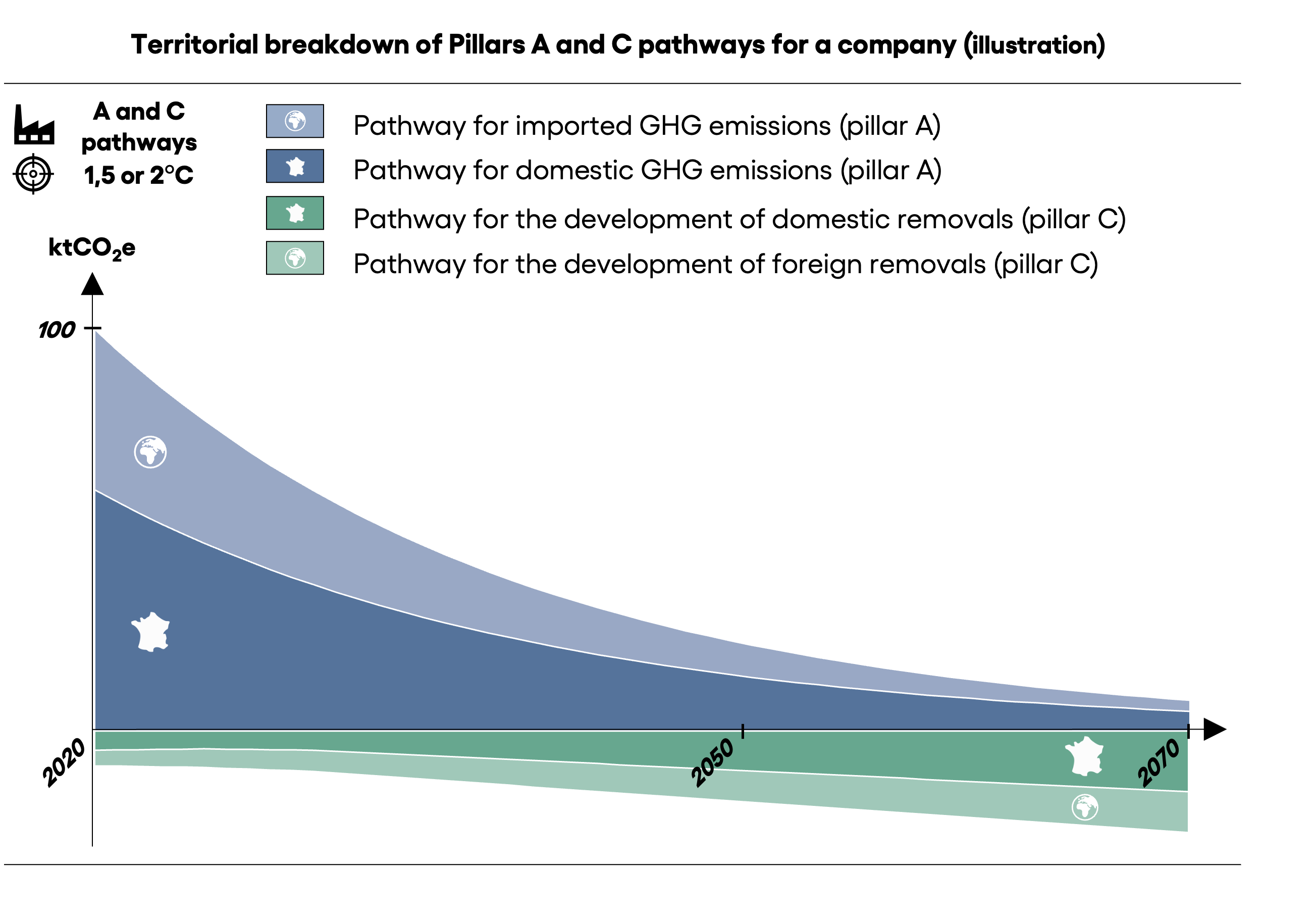Net Zero Initiative — 2020-2021 Report
In April 2020, Carbone 4 published the Net Zero Initiative reference framework, laying the foundations for a new interpretation of the issue of "net zero emissions" at the corporate level.
Since the only scientifically valid definition of net zero so far applies only to the planet[1], and possibly to state actors[2], the Net Zero Initiative has sought since its creation to think of the company not as an object that can be "neutral" in itself, but as one that should contribute at the right level to the objective of global and national carbon neutrality.
Consequently, the notion of a "net zero" or "neutral" company has been abandoned in favor of independent indicators that measure a company's climate performance against the global net zero requirement at any given time.
The Net Zero Initiative framework can be seen as a generalization of the carbon footprint concept, since it integrates it (Pillar A) while enriching it with two additional indicators: the company's capacity to participate in the decarbonation of third parties (Pillar B), and its capacity to develop carbon removals (Pillar C). These three Pillars are strictly independent of each other and are not fungible.
In 2020, the second season of the Net Zero Initiative wanted to explore two major issues:
Measuring Pillar B (avoided emissions): what metrics and calculation rules should be applied to measure a company's ability to contribute to the decarbonation of its ecosystem?
Setting objectives for Pillar C (carbone sinks): what is the right level of contribution to increasing carbon removals for a company?
Summary of the NZI 2020 recommendations
Pillar B measurement
▶ Categories B2 (emissions avoided by products and services) and B3 (project finance outside the value chain) should be reported separately.
▶ The metric for the calculation of B2 and B3:
➡ B2 (contribution to decarbonation through products and services sold):
- The impact should be reported in avoided emissions (tCO2 avoided), making a clear distinction between whether these avoided emissions correspond to a real reduction in emissions at the customer (AER) or whether they represent only a lower increase in the customer's level of emissions compared to a "worse" situation that could have happened instead (AELI).
- The company must also disclose the share of turnover corresponding to the sale of the products and services for which the avoided emissions were calculated.
➡ B3 (financing of decarbonation projects outside the value chain):
- The impact should be reported both in terms of emissions avoided (tCO2e avoided)[3] and the amount of funding committed by the company (euros)[4].
- The cost per ton avoided (i.e. the ratio between the funding and the amount of emissions avoided) can also be reported.
▶ When calculating the emissions avoided by products and services (B2), the correct baseline scenario should be chosen, which aims to describe as accurately as possible what would have happened without the product in question.
▶ The emissions in the baseline scenario ("what would have happened") are not necessarily stable over time. It is therefore necessary to anticipate its future variation, in particular by considering the evolution of the market trend and the state of regulation.
▶ The reference scenario can be constructed by paying particular attention to the following parameters:
- Context of the sale: is it a replacement of equipment at the customer's premises, or a new piece of equipment?
- Geographical context
- Market segments
- Age of the products being replaced
- Customer profile
▶ Avoided emissions should always be calculated using a "life cycle" approach, i.e. considering all the emissions of a project in relation to the baseline, from manufacture to use to end of life.
▶ The avoided emissions of a product must be allocated to the actors of a value chain using the same allocation rule as for the emissions of the use of this product (Pillar A).
▶ The rules for calculating normative targets on B2 and B3 will be the subject of the NZI 2021 work.
Setting targets on the Pillar C
A company's responsibility for sink development is twofold:
▶ Overall objective for pillar C
Each company is expected to participate in the development of removals because it is part of the climate problem, as a GHG emitter.
▶ Specific objective for sinks in the value chain
In particular, companies involved directly or indirectly in the management of sinks have an operational responsibility to safeguard and develop these sinks, which is not necessarily linked to their responsibility as an emitter. This responsibility lies specifically with companies that have sinks in their value chain (categories C1 and C2).
Pillar C target
For a given company, the quantity of removals to be developed in year N is deduced from:
- The company's emissions trajectory (Pillar A) in year N, according to a 1.5°C or 2°C scenario;
- The absorption/emission ratio of the territory in which the company is identified in year N, according to a 1.5°C or 2°C scenario.
Thus, at any given time, the company's ratio (Pillar C / Pillar A) must be equal to the removals/emissions ratio of the territory with which it is identified (whether it is the planet or the national territories where its activities take place).
The company is invited to start with a simple approach (consider that the territory considered is the planet, or a single national territory), and then to "territorialize" its objectives more and more as its ambition and knowledge of the location of its emissions increases.
In order to develop removals in practice, the company is invited to collaborate with the actors in its value chain to co-lead this development effort, in order to limit double counting.
Specific objective on sinks in the value chain (C1, C2)
Companies with carbon sinks in their value chain have an important role to play in achieving global carbon neutrality, as direct or indirect managers and operators of these sinks. For this reason, they should set targets for the development of these sinks, without making these targets dependent on their Pillar A emissions. The rules for setting such targets on C1 and C2 will be the subject of further work, although several avenues can already be sketched out.
Next steps
The 2021-2022 edition of NZI will focus on further developing the rules for calculating avoided emissions for three sectors of the economy: transport, buildings and energy industries. At the time of writing, the 2021-2022 season of NZI is supported financially and/or methodologically by ADEME, the French Ministry of Ecological Transition (MET) and fifteen companies.






















